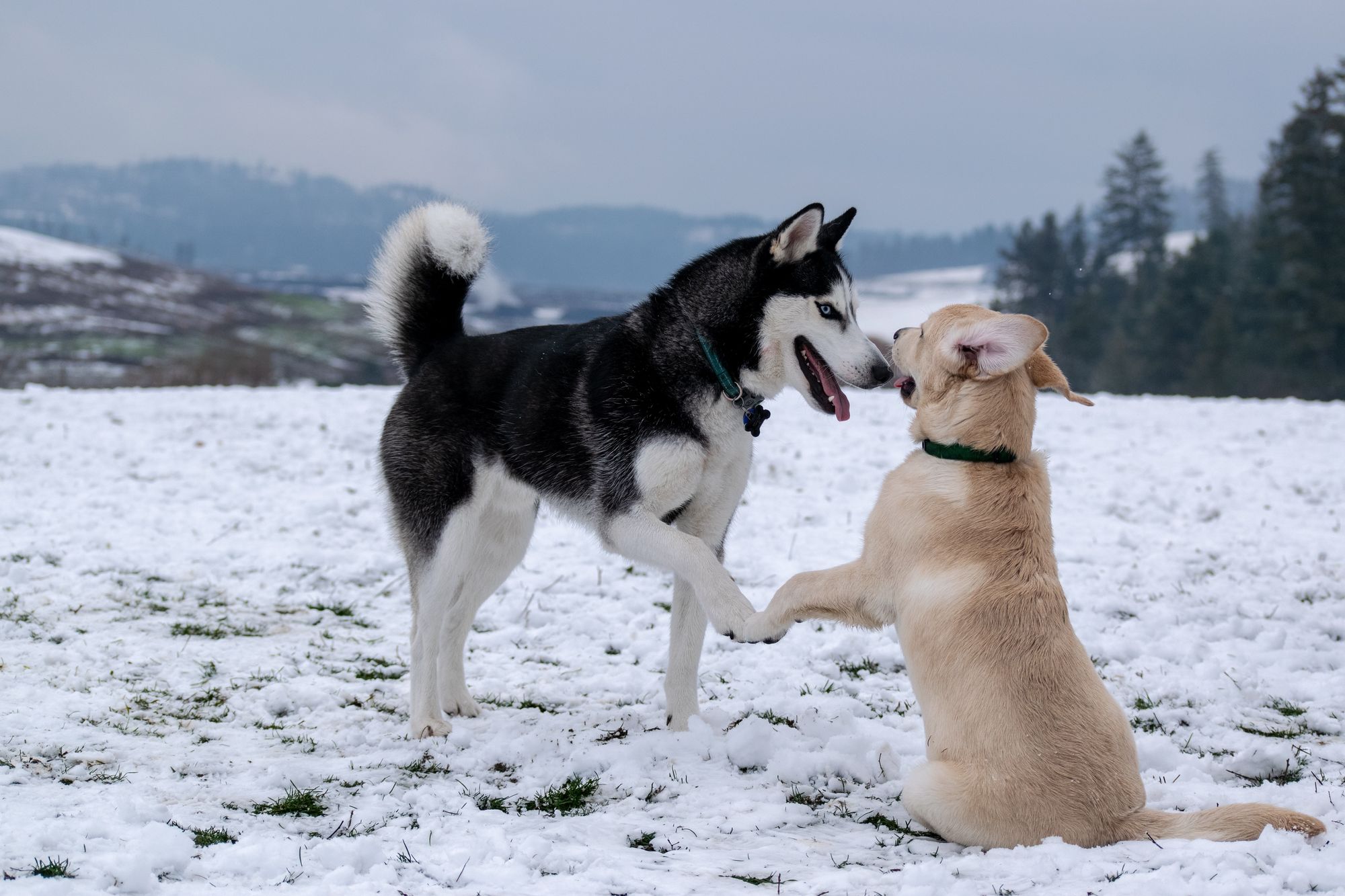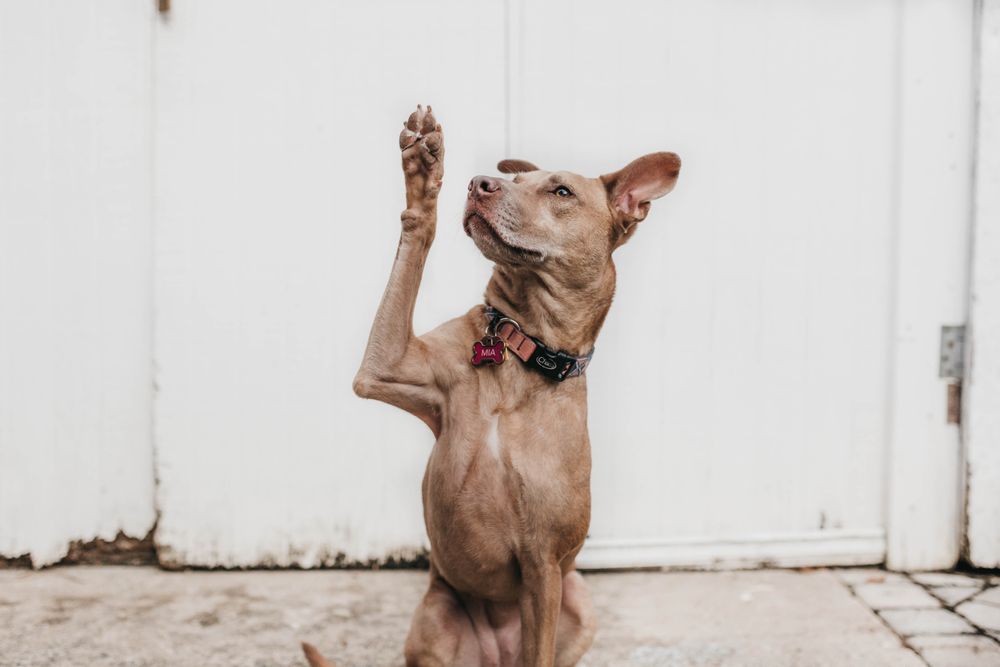Barking is one of the ways dogs communicate with humans and other dogs. They bark for many reasons: In response to sights and sounds, fear, stress or anxiety, frustration, boredom, and to tell other dogs they want to play. While barking is a totally normal dog behavior, this article will help you understand:
- What causes dogs to bark at other dogs
- Whether or not barking is a sign of aggression
- How to train your dog to stop barking at other dogs
- What other pet parents are asking about dogs barking at each other
Let’s get started!
What causes dogs to bark at other dogs?
Dogs bark at other dogs for many reasons that range from excitement, to showing frustration, and even communicating fear and anxiety. These five categories of barking may help you understand what’s triggering your dog to bark at other dogs:
- Attention-seeking or frustration barking. Typically higher-pitched, and your dog will be looking at the other dog.
- Distance-increase barking. Typically lower pitched and intended to help your dog create space from the other dog. Your dog’s body language will be tense, and may be accompanied by moving back and forth towards the perceived threat (i.e the other dog).
- Hello barking. Typically high pitched or whiny, and accompanied by a wagging tail and loose body. This type of barking is typically seen when a dog greets another dog or person.
- Playful barking. Typically sounds like playful growls and is accompanied by “play bows” (i.e. dog bows front legs) and a wagging tail. This behavior is a sign that your dog is happy and wants to play with the other dog.
- Territorial barking. Typically lower-pitched and results in your dog moving in the direction of the dog they’re barking at. This type of barking is common when a dog is in a backyard, driving in the car, or sitting on a porch in front of their home.
Determining why your dog is barking is the first step to managing their barking behavior.
Is barking at other dogs a sign of aggression?
In the majority of cases, barking isn't a sign of aggression, but instead a sign that your dog is uncomfortable and they are trying to tell others to stay away. To get a better understanding of how your dog is feeling, observe their body language in relation to their barking. Areas to pay attention to include your dog’s:
- Tail. A loose tail or propeller-like wag usually indicates your dog is feeling friendly. On the other hand, a stiff or high tail may indicate that your dog is on guard.
- Ears. Ears held in a natural position typically indicate that your dog is relaxed. On the other hand, ears that are held up and forward may indicate a willingness to fight or general aggression towards the other dog.
- Eyes. “Soft Eyes,” a warm, sometimes squinty look, usually means your dog is friendly and willing to interact. On the other hand, “Hard Eyes,” a cold, icy look usually associated with a direct stare, usually indicates that your dog may be prepared to fight or aggress forward.
- Mouth. A mouth that is slightly open, with no teeth exposed, generally means your dog is relaxed. Whereas a frightened dog may pull the corners of his lip back (“lip long”) and a dog that needs space may pull their lips back, bare their teeth and wrinkle their muzzle. This action is designed to intimidate the other dog from moving closer.

How do I train my dog not to bark at other dogs?
If your dog barks at other dogs on walks, and is lunging or moving back and forth, they are likely uncomfortable and asking for space from the other dog. In this situation, there are a few things you can do:
- Create enough distance between yourself and the other dog. Because your dog is fettered, they think they need to bark in order to create distance between themselves and the other dog. When you see another dog, try a swift u-turn and walk the other way to help create distance between your dog and the other dog. By creating that distance for them, you are helping reduce their stress levels and under threshold (i.e. below their emotional boiling point and not barking).
- Walk your dog at your side. Easier said than done, but this can be accomplished with loose-leash walking training. If you have not yet mastered that, distract your dog with treats as you move past the other dog.
- Position your body between your dog and the other dog. For instance, if the other dog is on your right, make sure your dog is on the left side of your body. Creating a physical divide will help create a sense of security for your dog. Practice cueing your dog to go to the other side of your body to make this happen.
- Give your dog LOTS of treats. Depending on your dog’s level of reactivity, this might mean handing them a great treat the second you spot another dog, or tossing the treat in a direction that’s away from the other dog. Especially at the beginning, we recommend continually feeding your dog treats until the other dog is far enough away.
- Encourage eye contact. The goal is for your dog to eventually look at you every time you encounter another dog, because they know that whenever they see another dog you’re going to give them something delicious! Be patient. Training is an ongoing process and this is something you'll work on with your dog over time.
Frequently asked questions about dogs barking at each other
What does it mean when a dog barks at another dog?
Dogs bark at other dogs for many reasons: To say hello, indicate they want to play, ask for distance, share feelings of frustration, and indicate that another dog is unwelcome in their territory. Determining why your dog is barking is the first step to managing their barking behavior.
Should I allow my dog to bark at other dogs?
Barking is one of the primary methods dogs use to communicate with other dogs and an important indicator for understanding how your dog is feeling. You should not punish your dog for barking, but instead focus on understanding the underlying reason for why they’re barking. Understanding why your dog is barking will help you determine what to do next. For example, if your dog is barking in a low pitched tone, and moving back and forth towards the other dog, your dog is likely uncomfortable and you should move away from the other dog.
Why does my dog bark at some dogs but not others?
Barking could be due to excitement, fear, the need for space, a desire to play or territorial behavior. Evaluating your dog’s barking in relation to their body language will help you determine why your dog is barking at the other dog.




